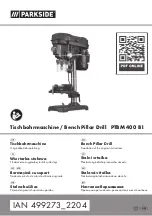
12
◆
For screwdriving, set the collar to the desired
setting. If you do not yet know the appropriate
setting, proceed as follows:
◆
Set the collar (3) to the lowest torque setting.
◆
Tighten the first screw.
◆
If the clutch ratchets before the desired
result is achieved, increase the collar setting
and continue tightening the screw. Repeat
until you reach the correct setting. Use this
setting for the remaining screws.
HP122K(D)/HP142K(D) - Drilling in masonry
(fig. H & I)
◆
For drilling in masonry, set the collar (3) to the
hammer drilling position by aligning the
symbol
with the marking (21).
◆
Slide the two-gear selector (5) towards the
front of the tool (2nd gear).
HP122K(D)/HP142K(D) - Two-gear selector (fig. I)
◆
For drilling in steel and for screwdriving
applications, slide the two-gear selector (5)
towards the rear of the tool (1st gear).
◆
For drilling in materials other than steel,
slide the two-gear selector (5) towards the
front of the tool (2nd gear).
Straight drilling indicator (fig. J)
This tool is fitted with an indicator to facilitate
straight drilling. This feature can be used both in
horizontal and in vertical position.
◆
Position the tool as required.
◆
Keep the switch (1) slightly depressed without
switching the tool on.
◆
Slowly move the rear of the tool until the red
indicator (22) lights up.
◆
Press the switch further to start drilling.
HP12KD/HP14KD/HP122KD/HP142KD -
Detecting pipes or wires (fig. K)
◆
Take the detector (23) out of the holder (24).
◆
Refer to the manual of the detector for further
instructions.
Drilling/screwdriving (fig. A)
◆
Select forward or reverse rotation using the
forward/reverse slider (2).
◆
To switch the tool on, press the switch (1).
The tool speed depends on how far you press
the switch.
◆
To switch the tool off, release the switch.
Hints for optimum use
Drilling
◆
Always apply a light pressure in a straight line
with the drill bit.
◆
Just before the drill tip breaks through the
other side of the workpiece, decrease pressure
on the tool.
◆
Use a block of wood to back up workpieces
that may splinter.
◆
Use spade bits when drilling large diameter
holes in wood.
◆
Use HSS drill bits when drilling in metal.
◆
Use masonry bits when drilling in soft masonry.
◆
Use a lubricant when drilling metals other than
cast iron and brass.
◆
Make an indentation using a centre punch at
the centre of the hole to be drilled in order to
improve accuracy.
Screwdriving
◆
Always use the correct type and size of
screwdriver bit.
◆
If screws are difficult to tighten, try applying a
small amount of washing liquid or soap as a
lubricant.
◆
Always hold the tool and screwdriver bit in a
straight line with the screw.
MAINTENANCE
Your Black & Decker tool has been designed to
operate over a long period of time with a
minimum of maintenance. Continuous satisfactory
operation depends upon proper tool care and
regular cleaning.
Your charger does not require any maintenance
apart from regular cleaning.
◆
Before performing any maintenance on
the tool, remove the battery from the
tool.
◆
Unplug the charger before cleaning it.
E N G L I S H
Summary of Contents for HP122K
Page 1: ...1 HP96K HP12K D HP14K D HP122K D HP142K D ...
Page 2: ...2 Copyright Black Decker ...
Page 3: ...3 A 9 10 7 4 5 6 11 15 14 3 2 1 12 13 8 ...
Page 4: ...4 13 15 14 9 C B D E 10 9 16 17 18 9 11 12 ...
Page 5: ...5 G F H 20 19 2 3 21 J 5 I 22 ...
Page 6: ...6 K 24 23 ...
Page 15: ...15 ...
Page 16: ...16 ...
Page 17: ...17 ...
Page 18: ...18 ...
Page 20: ...20 5100052 08 03 03 ...






































